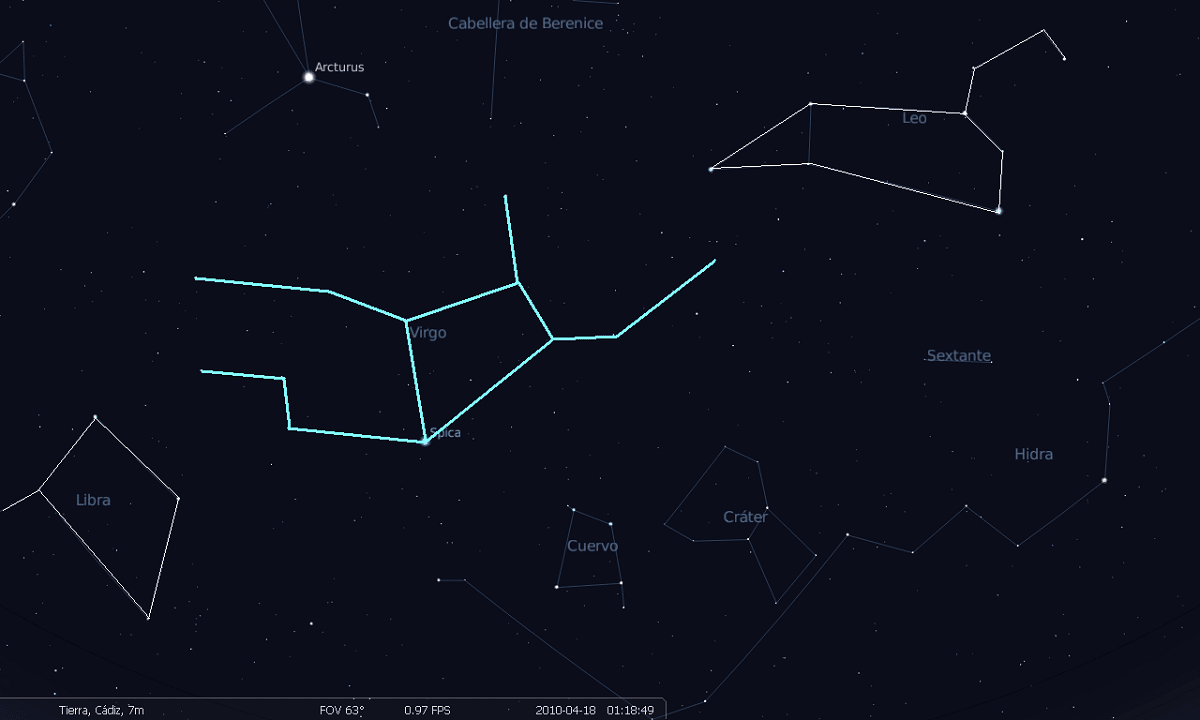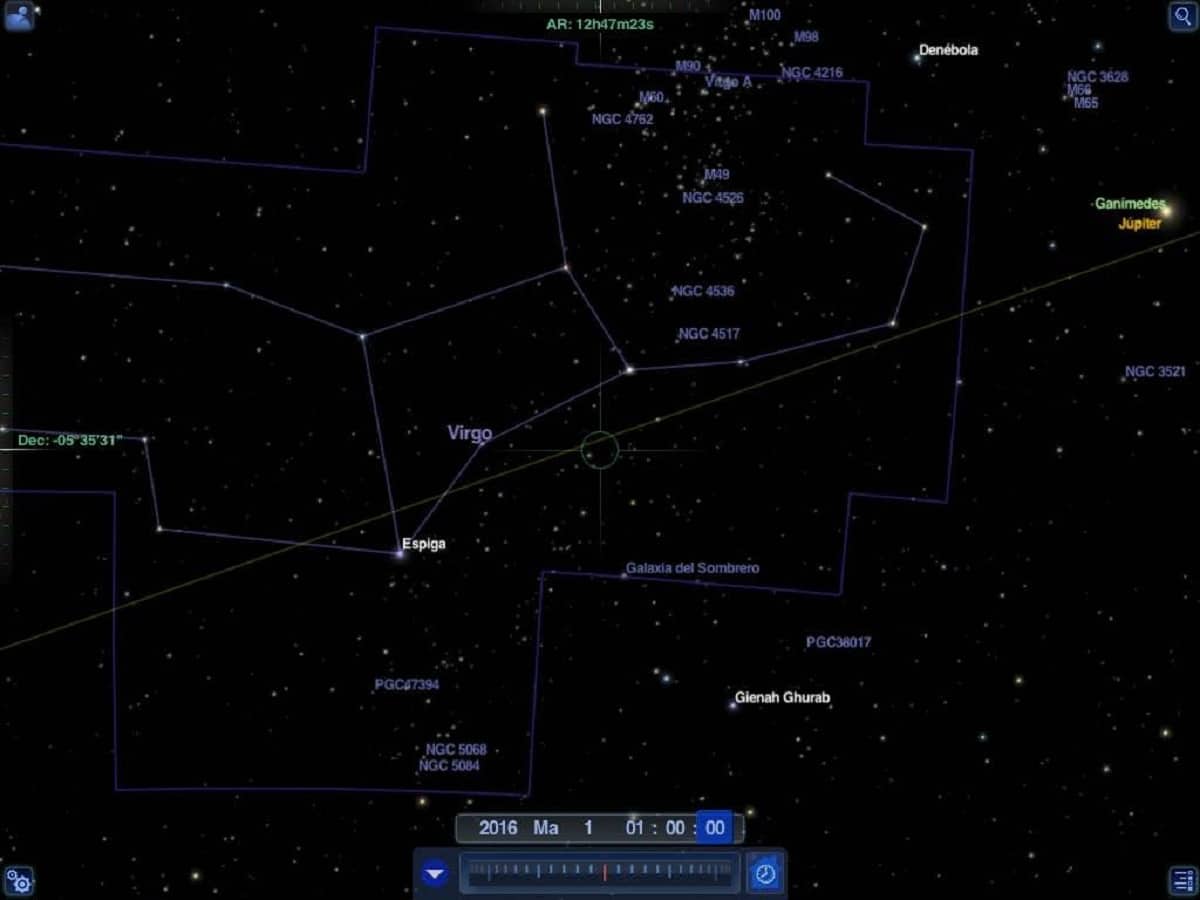
As we have already discussed in other articles, the constellations in the sky are a group of bright stars that have shapes and that have their name through the zodiac signs. One of the best known constellations of the zodiac is the Virgo constellation. This constellation receives this name in the plural because of the large number of stars that make it up and the magnitude of the brightness of each one of them.
Therefore, we are going to dedicate this article to tell you all the characteristics, origin and mythology of the constellation Virgo.
Key features

Virgo is 2º south of this circle. In the southern hemisphere, Virgo is an autumnal constellation located between 30º and 40º north of Centauri. Spica, one of its main stars, is roughly in the middle of the 100º arc, which runs between the first two ecliptic indicators of the zodiac: Antares (from Scorpio) and Regulus (from Leo).
The constellation of Virgo is one of the largest constellations of the celestial dome, with a square of almost 1300º, only surpassed by the constellation of Hydra in 1303º, it is in the celestial equator and it is visible in both hemispheres from February to August. It is also the greatest sign of the zodiac, so the sun stays in it for more than 40 days, especially 45 days, which is the longest solar month. The Virgo characteristic is that it is very close to the north pole of our Milky Way or galaxy, which means that we have a window open to the sky, overlooking the Milky Way and globular star clusters.
On the other hand, no star-rich fields or star clusters were observed. It is amazing to be able to imagine the realm of huge galaxies with a telescope and few stars. Virgo is bounded by the constellations Butes and Coma Belenica, with Leo to the east, the crater to the south, Corvus and Hydra to the west, and Libra and Sepens Kapu to the west.
The constellation Virgo is easy to observe in our northern hemisphere and can be used as an indicator to identify other constellations. Virgo contains a large number of distant galaxies, some of which are visible from telescopes to medium-sized telescopes. The sun passes through this constellation from September 16 to October 30.
In the order of the zodiac, this constellation is located between Lion in the west and balance in the east. It is a huge constellation (the second constellation in the sky after Hydra) and very old. Virgo also marks a constellation of the zodiac, which corresponds to the 30 ° sector of the ecliptic that crosses the sun from August 24 to September 22.
Virgo constellation mythology

In mythology, the constellation Virgo refers to the goddess Ishtar, who went to hell to seek to turn her love into the lover of the god Tammuz, who is called the harvest. When the goddess went to hell to find her lover, she was unable to leave, resulting in a desolate world. While the goddess Ishatar was trapped in hell and people watched in a sad and desolate world, the great gods decided to release her. This mythical event is related to an event that took place in Greece.
Happened in the history of Persephone, the event was kidnapped by Hades and implemented because Persephone's mother was kidnapped and Demeter prevented the harvest from causing all its destruction.
This myth is clearly related to the vegetative cycle of plants: sowing the seeds in autumn; germination, in spring and fruiting and harvesting in summer. The two main stars: "Spica" the ear and "Vendiamiatrix" the grape harvester mark the times of harvest of cereals and harvest respectively and link with the origin of this myth.
The constellation of Virgo is female, and formerly from its origin comes from the Assyrian-Babylonian culture, closely related between fertility and cleanliness, purity.
Main stars of the constellation Virgo

The constellation Virgo is made up of a grouping of very bright stars such as spica, zavijava, porrima, and vindemiatrix. Each one has a particular brightness and color but together they give a constellation beauty. Let's see what each of the main stars in the Virgo constellation are:
Spica
It is the brightest star and its shape resembles a figure that represents a common woman heading towards the Equator. The elliptical is located to the north and is located 2 degrees to the south. Spica is found between the Antares or Scorpio and Regulus or Leo, known as first-dimensional indicators within the lower and upper limits, that is, right in the center of a 100º arc.
This Spica star is known as ¨the spike¨, the dimension of its color is 1 because it is from blue to blue-white.
Zavijava
30 is a star that has poor visual definition. It has a magnitude of 3.8 and its brightness is related to a shade of yellow that appears to be cloudy or pale. The meaning that astronomy experts have given to this star is corner.
Last
It is a star whose name is in presentation of the Roman goddess Porrima. It has a magnitude of 2.8 and has a yellow-white color.
Vindemiatrix
This star has its name that comes from the word harvester. It means the action of the vintage. It has a magnitude of 2.8 and has a totally yellow color.
As for the planet that represents the constellation Virgo, we have the planet Mercury. Since the irgo is the sixth or sign of the zodiac, it gives the person who has this sign a passion for every detail and enthusiasm in situations where other people find it insignificant. That is why it makes the planet contribute to the emotional organization of people.
I hope that with this information you can learn more about the constellation Virgo, its characteristics and its mythology.